Subscribe now and get the latest podcast releases delivered straight to your inbox.
How To Optimize Your Marketing Automation Workflows With HubSpot (Tips)

Nov 12, 2021
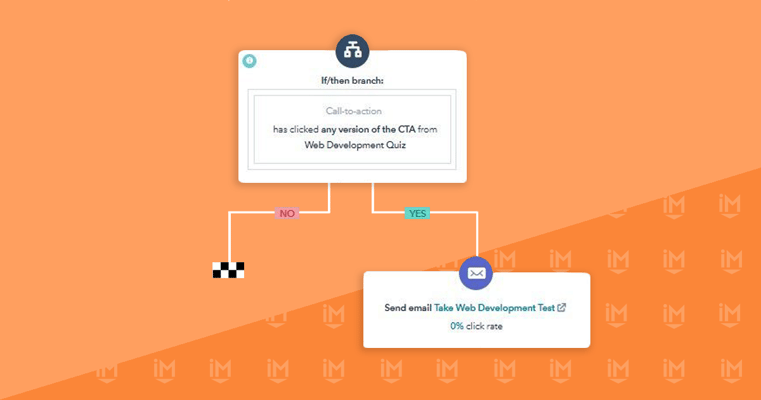
Marketers today constantly juggle a million hats. We’re tasked with writing and setting up emails, publishing lots of content, making sure leads are nurtured correctly, engaging with prospects on social media, and analyzing tons of data.
When you’re a marketer who manages all these moving parts (and let’s face it — most of us are), leaning on powerful tools that automate repetitive tasks can be a lifesaver. But for some, setting up marketing automation workflows to streamline our day-to-day processes — in a way that still provides value to prospects — can feel like a giant undertaking.
How do you know which processes you should integrate into a marketing automation workflow? And how do you optimize your workflows so they’re scalable, but still ensure prospects have a good experience working with you? (As in your outreach is largely automated, but doesn’t feel that way.)
We've worked with hundreds of businesses to optimize their marketing automation using tools such as HubSpot. These tips are what we teach our clients to help them structure their marketing and sales workflows in a way that streamlines everyday processes, but also fosters a positive experience along the customer journey.
When done correctly, this approach to automation can result in even greater traffic, leads, and sales for your business — and it’s likely easier to do than you think.
In this article, we share the following insights:
- What HubSpot marketing automation is and how it works.
- How to get the most out of HubSpot’s workflow automation tool.
- How to properly develop your HubSpot workflow automation strategy.
Ready to set up your HubSpot portal to automate those pesky, repetitive tasks — but still preserve a strong business-customer connection?
Here’s what to know.
What HubSpot marketing automation is and how it works
HubSpot’s marketing automation platform helps your marketing and sales teams improve their process and simplify day-to-day tasks. It enables your team to set up these tasks to trigger automatically based on a specific action.
This means that instead of your marketing team having to check every day to see if their outreach has gathered qualified leads, they can set up a system in HubSpot that automatically filters qualified leads and sends them to the right place at the right time.
With the HubSpot marketing automation tools and platform, your team can do the following:
- Clearly and accurately present data to your team. This is thanks to HubSpot’s multiple reporting dashboards and custom reporting capabilities.
- Take immediate action based on user information and data. When an action is taken by your website visitors, such as filling out a form, HubSpot can automatically enter them into a welcome email workflow, send their information to your sales team, and/or notify your team what content the visitor has read, among other automated functions.
- Tie your marketing efforts directly back to revenue. You need to know if the marketing actions you’re taking are generating more leads and sales. As long as your team is setting up and reporting things accurately, HubSpot can show how your marketing campaigns are doing and what needs improvement.
While we know you might not be using HubSpot to automate your marketing campaigns and tasks, as there are thousands of technologies out there that can help with marketing automation, we recommend HubSpot because it is able to do all this and more.
Here’s how to get the most out of your HubSpot’s automation tools so your marketing and sales teams can be even more efficient and successful in their engagement with prospective customers.
How to get the most out of HubSpot’s workflow automation tool
When it comes to automating actions within the HubSpot tool, you’ll likely use workflows the most.
HubSpot workflows allow you to set up a series of automated steps that help usher your contacts through the sales pipeline. They also give you the freedom to automate your marketing outreach in a way that helps prospects get the information they need at the moment they need it.
Marketing automation workflows can be set up in different ways, but some of the main methods include:
- Contact-based
- Company-based
- Deal-based
- Ticket-based
- Quote-based
HubSpot has more options as well, including marketing automation workflows based on conversations and feedback. You can also use templates of common workflows so you don’t have to start from scratch.
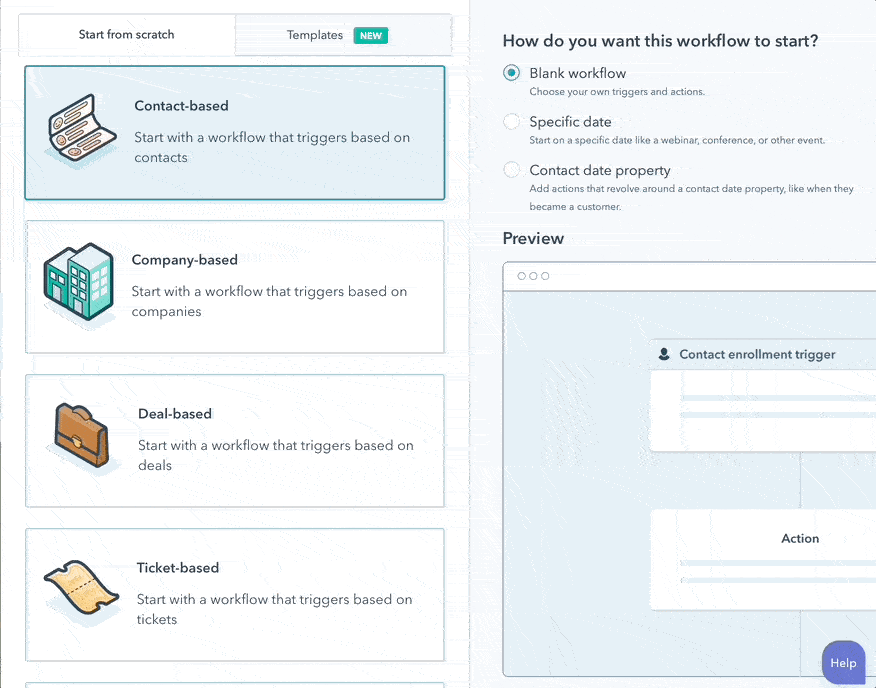
Once you set up the workflow, you’ll be able to choose how your contact is enrolled. For example, they can be enrolled based on how many pages they’ve viewed, whether they’ve submitted a form, or whether they’ve signed up for your newsletter:
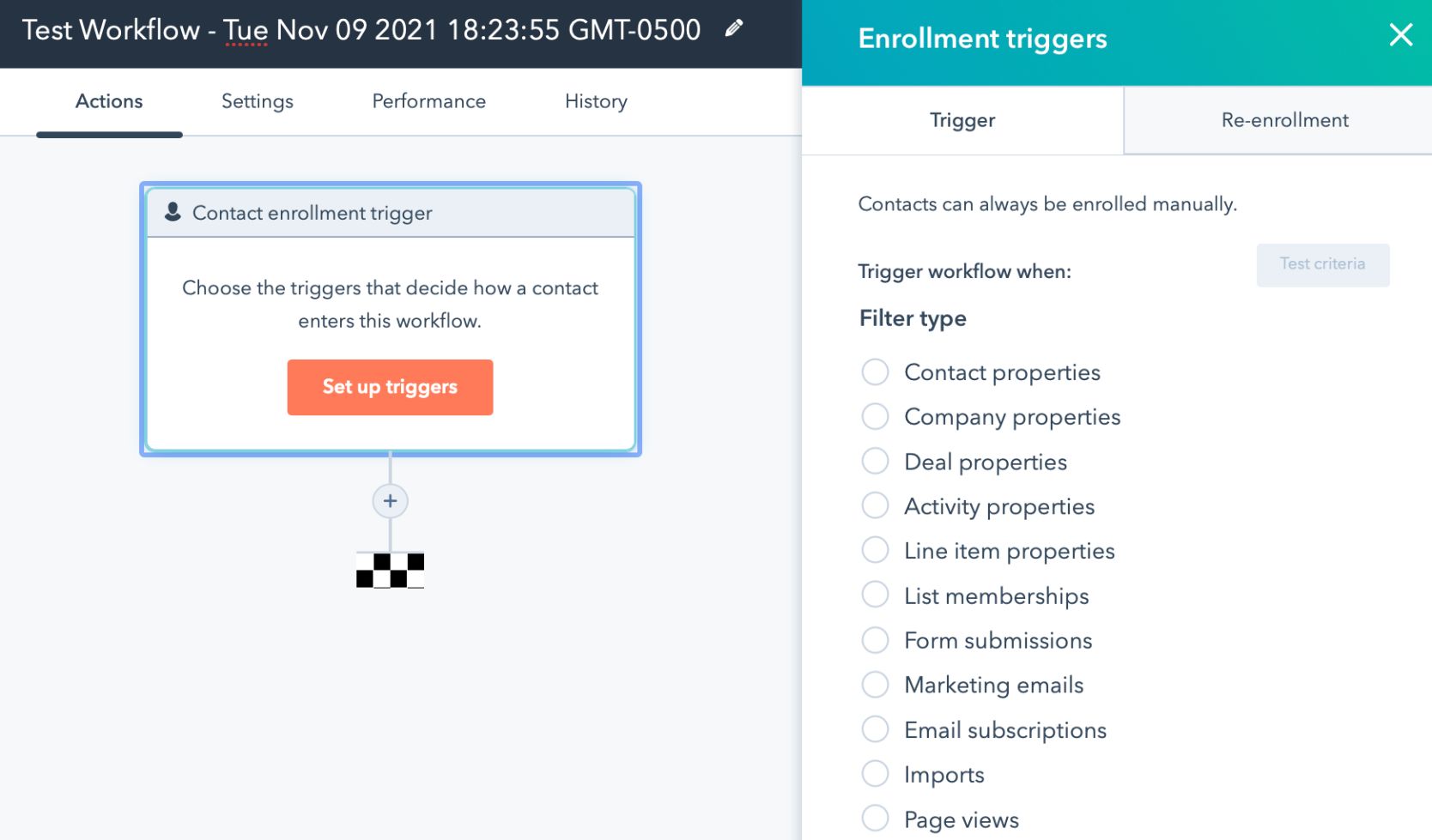
How you set up your workflows will depend on whether they’re for external use (for example, you might choose to set up a lead nurturing workflow designed to communicate with your prospects and customers) or internal (to communicate with other team members). The best and most effective marketing automation strategy will be set up with the right mix of both.
Here’s how to optimize your processes for each.
Optimizing HubSpot workflows for external purposes
External workflows are automated processes that help you communicate with your prospects and new customers. These marketing automation workflows include things like automated emails sent when a contact fills out a form or sending prospective customers educational information about a product or service.
The trick with these types of marketing automation workflows is making sure they’re sending the right information at the right time. For example, if someone downloads a product or service guide, your follow-up piece of marketing communication should include more relevant content about that specific topic, such as blog articles they could read.
As you’re setting up each marketing automation workflow, make sure it’s timely, personal, and based on how that contact is interacting with your website and content. In other words, you want your contacts to feel like they’re getting exactly what they need when they need it.
Here are the different workflows you can use for your external automation.
Form submission workflows
Every time a contact submits a form on your website, something needs to happen. It may be tempting to send out a blanket email to all users who fill out your forms, but your automated responses need to be specific and intentional (at least if you want them to be effective). This is how you avoid that spammy, automated feel.
For example, if someone submits a form on your website asking for a quote, the response to that submission should look a lot different than the reply to someone who just subscribed to your newsletter. This way, you’re always sending pointed emails with tailored content that is contextualized based on what the user is looking for.
As you can see, there are many ways to trigger these workflows (not only by a form submitted, but also by date, etc.):
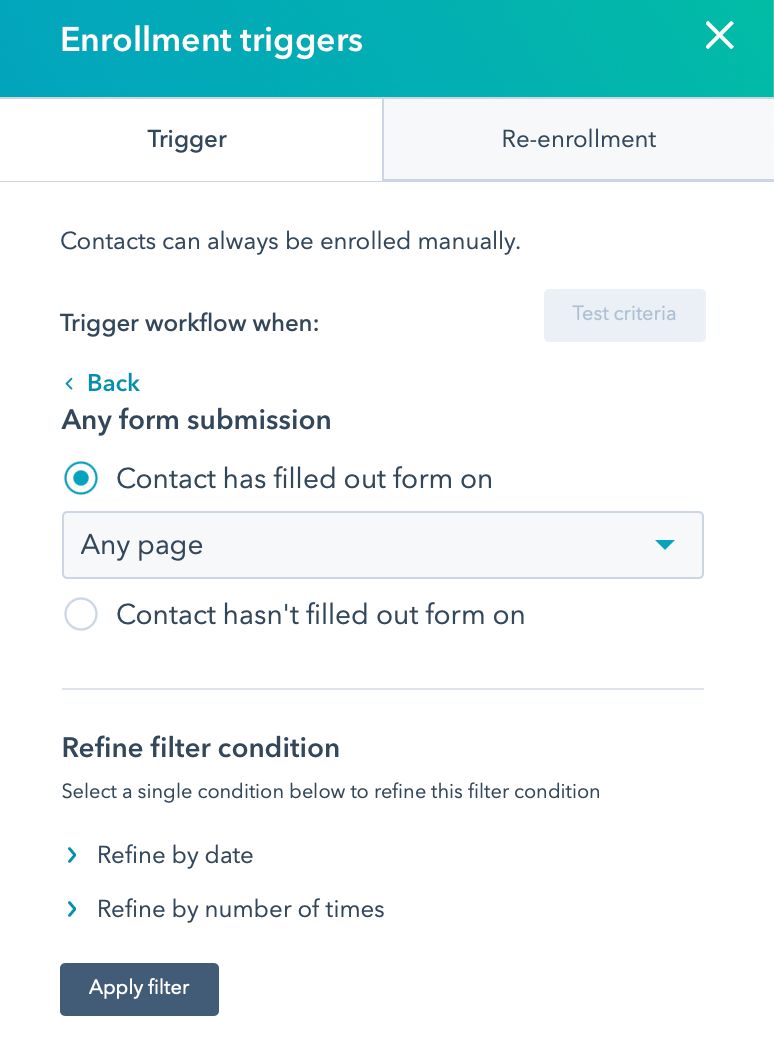
Pro tip: When updating an existing marketing workflow, check if there are people already enrolled. If so, it’s important to leave the “allow contacts to re-enroll” box unchecked, as long as that makes sense for what you’re trying to do.
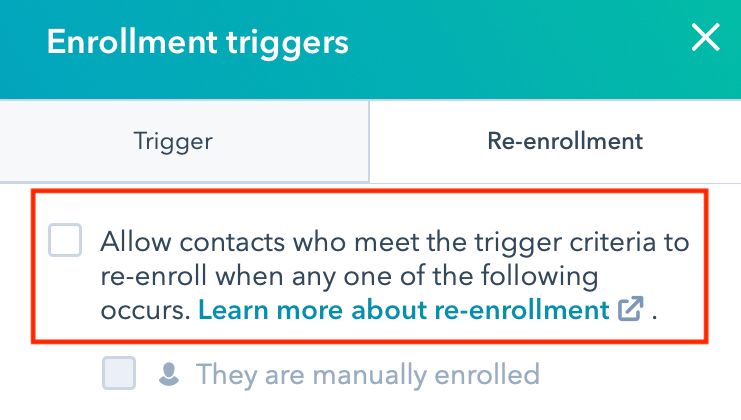
By checking the box, you’re telling HubSpot to enroll those in the workflow again, which means they could be sent marketing emails out of context.
This tip applies for all workflows, too — not just form-submission workflows — so be sure to do what’s appropriate for the action if you want to avoid accidentally spamming your prospects with out-of-context emails.
Email lead nurturing workflows
When your lead nurturing workflow uses email, the goal is to keep prospects engaged with your content and move them along toward a sale. These emails typically include educational material for people looking to weigh their options or information on next steps the prospect should take if they’re ready to make a purchase.
The thing you have to be careful with here is that you don’t want to try to jam people into the next phase of the lead nurturing or sales funnel if they’re not ready yet, or you risk your emails being ignored or marked as spam.
Your automated email workflows should serve one purpose: to provide your prospects with something valuable. Value-driven emails build trust, and when your prospects trust your business, it’s more likely they’ll buy from you.
Email lead nurturing workflows can have several enrollment triggers, depending on who you’re targeting and what your goals are for that campaign.
For example, if someone requested a quote, they’re likely further down the sales funnel, which means you might not have to market to them further, and they can go right to your sales department. If they download a helpful guide to learn more about your products or services, this indicates you could send some more relevant content that is specific to the topic they are interested in.
Pro tip: These workflows are typically set up with delays within the automation software with the assumption that you don’t want your contacts or new customers to get all four emails of your workflow at once. This means you can send an email to your contact the minute they fill out a form, but then wait a few days before sending a second one.
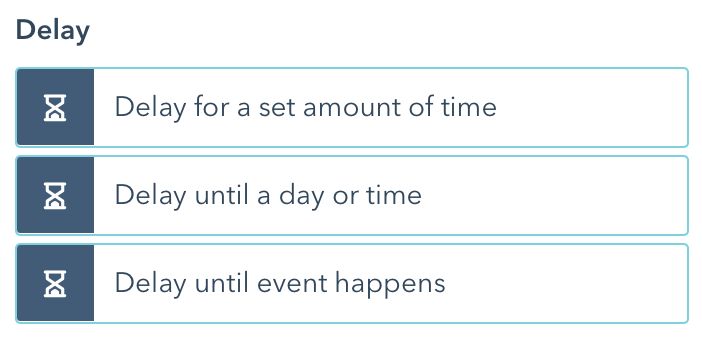
We often get asked how long to wait between emails, but the answer is it depends on how long your sales process is. For example, if your typical sales pipeline happens over the course of a week, the emails should go out pretty quickly. If your sales process takes months to years, your email should go out a few weeks or months apart.
But don’t spend too much time figuring this out. Get it started and monitor the results — you can always adjust.
Re-engagement workflows
As your contact database grows, you will inevitably have contacts that haven’t bought from you yet, but who also haven’t engaged with your content in a while. These contacts are what we call “unengaged.”
When your unengaged contacts list is small, it’s not too big of a concern. But HubSpot has you pay in tiers based on how many contacts you have in your database, so it’s definitely in your best interest to keep your list updated with engaged contacts only.
It’s helpful to send your unengaged list an email that gets them to either re-engage with your company or let you know they’d like to be removed from your database.
Enrollment in these workflows should use a combination of data related to user behavior, such as:
- Sends since last engagement, which tracks how many emails they’ve received since they engaged with your emails or website.
- Time last seen, which is when they last visited your website. If it’s more than a few months ago, they’re probably not engaged.
- Lifecycle stage, which helps you exclude sales-qualified leads, opportunities, or existing customers who might look like they’re not engaged but are further along in the sales process.
Why would you want to get rid of HubSpot contacts? You might be thinking you’d like to keep their information, even if they’re not engaging with you.
In our experience, this seems to come from a “But, maybe one day they’ll buy!” mentality.
The bottom line is weeding out uninterested prospects will keep your database clear of unqualified leads, who you don’t want to waste your time (or money) engaging with anyway.
Pro tip: Expect your re-enrollment emails to have a high unsubscribe rate. But don’t worry — this is a good thing! It’s better to know who doesn’t want to be getting your emails than having that contact sitting in HubSpot.
Remember, your re-enrollment workflows should not only re-engage some contacts but also eliminate those who have little interest in your offerings.
It’s a win-win.
Optimizing HubSpot workflows for internal purposes
Now that you know how to optimize your external workflows, let’s take a look at those internal ones that automate processes for your team.
There are three major types:
- Internal notifications, which are set up to notify your team members when something happens, such as if a prospect reads five or more pages of your website or fills out a “contact us” form.
- Lead qualification and hand-off, when automated, make it much easier to pass on contacts from marketing workflows to sales.
- Data management so that keeping track of the data and understanding which efforts are working doesn’t have to be so difficult.
Here’s how to be sure you’re setting your team up for success with internal HubSpot workflows.
Internal notifications
Internal notifications are just what they sound like: automated actions that allow you to keep various team members in the loop about what’s happening in your marketing campaigns.
For example, at the end of a lead nurturing email, if the prospect has engaged with everything you sent them but hasn’t had a sales conversation yet, they can automatically be sent to a member of your sales team.
Someone on your sales team might also want to get notified about specific enrollment triggers. For example, say you have a sales rep who needs to know which recent leads have been consuming lots of content.
A set of triggers might look like this or something similar:
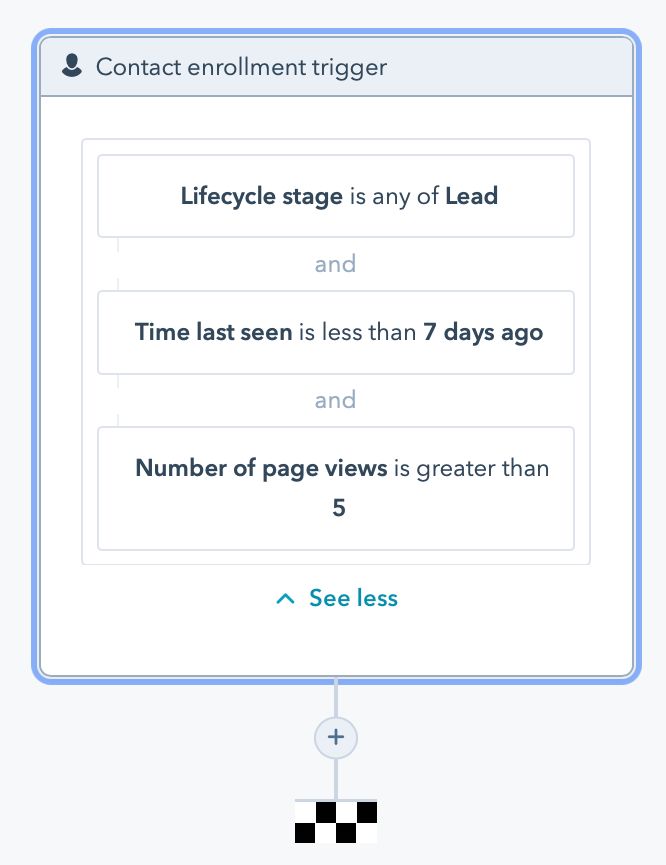
Pro tip: There are generally four different ways to set up your internal notifications:
- Email notifications; plain-text emails created directly in the automated workflow tool.
- Marketing emails; emails created and saved in your marketing email tool that, once set up, can be pulled into the workflow.
- SMS or text messages; which might be helpful for sales team members who travel often.
- In-app notifications; which are the notifications directly in and from HubSpot.
There is no right or wrong way to set these up — it depends on what works for your team and how they prefer to be notified.
Lead qualification and hand-off
These automated workflows eliminate the manual work it takes to vet new leads coming in and route them to the appropriate place. This typically means you’re either sending them off to another marketing campaign if they need more information to make a purchase — or to your sales team if they’re ready to buy.
You can automate this process so that as soon as a lead comes in they are automatically sent to the appropriate sales team member or enrolled in the appropriate marketing campaign. You need to first determine what your qualification criteria is and when a lead should be handed off to sales.
Pro tip: By using a series of if/then branches, you can use the information the contact submits on your form to check if they meet your sales qualification criteria. If they do, you can use this information to route them to and notify the appropriate salesperson.
Make sure these workflows are set up and agreed upon with your marketing and sales team. You’ll want your sales team to have a say in whether or not they want to talk to a lead and at what point they’re the most qualified.
Also, if you find yourself using three or more properties for qualifying leads, you may want to use HubSpot’s lead-scoring functionality to set up your triggers so your workflow isn’t too complex or confusing.
Data management
You don’t want your team to manually update data properties all the time — and the beauty is they don’t have to.
You can set up your workflows to update property values automatically.
One of the most common property values to automate is the contacts’ lifecycle stages. This might be something like, if a prospect reads 10 pages of our website, downloads our guide, and fills out a “contact us” form, then they are automatically considered a qualified lead.
You can get really creative here and come up with lots of ways certain enrollment criteria can help keep your data squeaky clean. It basically comes down to your team’s wants and needs in terms of HubSpot contact property management.
Pro tip: If a contact or someone on your team updates a property, such as the industry for a company record, it can automatically be applied to all associated contacts. You can set this up to update your data based on all contacts associated with the company. But sometimes contact property changes can be updated across the board.
How to properly develop your workflow automation strategy
When setting up your HubSpot portal to automate your marketing to-dos, you never want to automate just because you can. Everything you choose to set up with automation should have a purpose.
So before you start automating every little thing, here’s what to know: Just because you can automate something doesn’t mean you should.
Automation should never come at the expense of your customer relationships.
You first need to develop your marketing automation strategy by taking these steps:
- Take stock of the manual tasks your team does on a daily basis. Things like: sending follow-up emails or updating information in your customer database. These are the “low hanging fruit” of automation.
- Think about the ways you can make your customer journey even better. This can be things like quick response times or sending prospects information that helps them move through the sales pipeline.
Once you understand what you want to accomplish, lay out the ways marketing automation can help you meet those goals. It can be as simple as an automatic email in response to a contact form submission, or as complex as a series of pathways that prospects go through depending on their actions (if someone fills out this form and downloads this guide, then we send them this piece of relevant content, etc.).
What’s important is that you implement your strategy — not wait until you get it perfectly down on paper first. This means you should get your automated workflows out there and implement them, and then focus on testing and improving as you go.
We often see our clients try to put it down on paper the best way they can before actually setting it up! Most automation strategies need work anyway, so plan it out, get it going, and set it in action. The sooner you do, the sooner you can refine the process.
Optimize your HubSpot workflows better with IMPACT
To learn even more about setting up and tracking HubSpot workflows, watch IMPACT’s HubSpot Trainer Carina Duffy’s course, “Marketing Automation Mastery (with HubSpot Workflows)” and follow along step by step.
All these tips we shared with you on how to get your sales teams using HubSpot illustrate those we recommend to our very own clients using our They Ask, You Answer framework. It has helped them overcome the obstacles many marketing teams face and go on to generate a healthy, more efficient sales pipeline and millions in revenue.
Also check out these additional resources to help you grow your business with inbound marketing:
With strategic coaching and hands-on training for your sales teams, we can help your company improve your marketing efforts and scale your business.


Order Your Copy of Marcus Sheridan's New Book — Endless Customers!